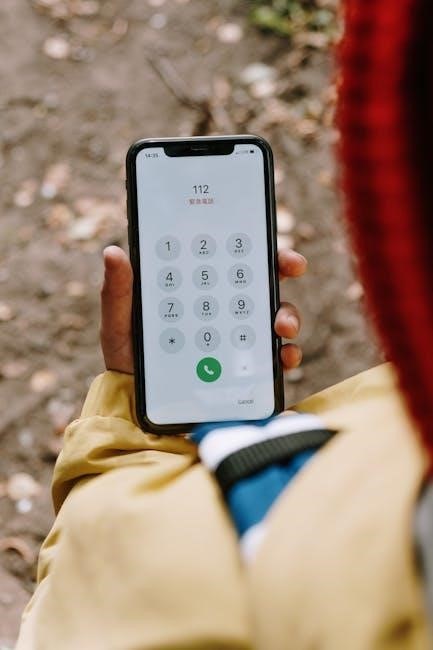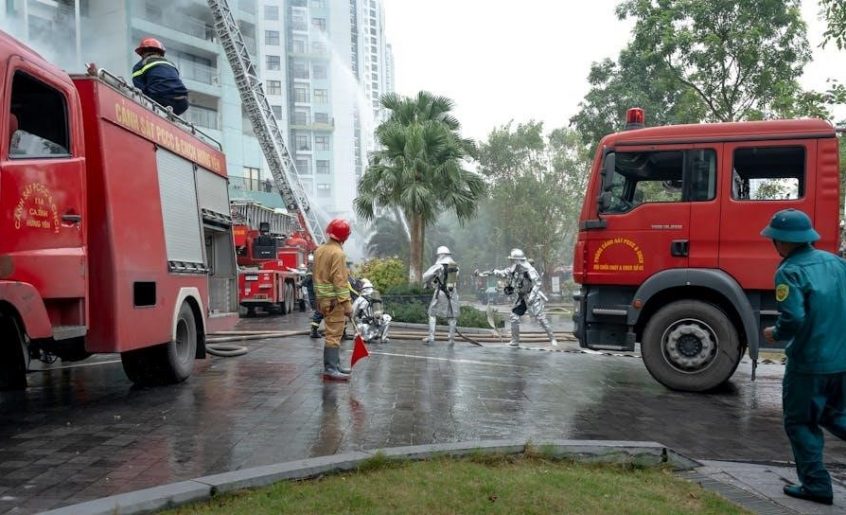Thank you for choosing First Alert for your smoke and carbon monoxide alarm needs. This state-of-the-art alarm provides early warning for smoke and CO dangers, ensuring your family’s safety with reliable detection.

Key Features of the First Alert Smoke and Carbon Monoxide Alarm
This alarm combines smoke and carbon monoxide detection, offering dual protection with advanced sensors. It features a 10-year sealed battery, voice alerts, and smart app connectivity for enhanced safety and convenience.
2.1 Combination Smoke and Carbon Monoxide Detection
The First Alert Smoke and Carbon Monoxide Alarm features a unique combination design, providing dual protection against two deadly household threats in one unit. This all-in-one detector uses advanced sensors to monitor for both smoke particles and carbon monoxide levels, ensuring comprehensive safety. By integrating both detection mechanisms, it eliminates the need for separate devices, saving space and simplifying installation. The alarm alerts users to potential dangers with clear, distinguishable signals, allowing for quick response to either a fire or CO buildup. This combination approach enhances overall home safety while maintaining reliability and ease of use, making it a vital component of any home’s safety system.
2.2 Types of Sensors Used
The First Alert Smoke and Carbon Monoxide Alarm utilizes two advanced sensor technologies to ensure accurate and reliable detection. For smoke detection, it employs a photoelectric sensor, which is highly effective at identifying smoldering fires by detecting visible particles of combustion. This sensor is particularly sensitive to larger smoke particles, making it ideal for early warning in slow-burning fire scenarios. For carbon monoxide detection, the alarm uses an electrochemical sensor, which provides precise monitoring of CO levels over time. This sensor is designed to detect the cumulative buildup of carbon monoxide, ensuring timely alerts to dangerous concentrations. Together, these sensors work seamlessly to provide comprehensive protection against both fire and carbon monoxide threats, offering peace of mind for homeowners and their families.
2.3 Battery and Power Options
The First Alert Smoke and Carbon Monoxide Alarm offers flexible power options to meet different installation needs. Many models feature a 10-year sealed lithium battery, which eliminates the need for frequent replacements and ensures continuous protection. For added convenience, some alarms are AC-powered with a battery backup, providing reliable operation even during power outages. The battery backup typically uses a 9-volt battery, which is easy to install and replace when necessary. These power options ensure that the alarm remains functional at all times, offering peace of mind for homeowners. Regular testing of the battery is recommended to maintain optimal performance and safety. By incorporating advanced power solutions, First Alert alarms are designed to provide long-lasting protection against smoke and carbon monoxide threats. Proper installation and adherence to the manual’s guidelines are essential for ensuring the alarm operates correctly.

System Requirements for Installation
For proper installation, ensure compatibility with smart home systems and Wi-Fi connectivity for app integration. Check device interconnectivity to ensure seamless communication with other alarms in your home.
3.1 Smart Features and App Compatibility
The First Alert Smoke and Carbon Monoxide Alarm integrates seamlessly with smart home systems, offering enhanced functionality through the First Alert App. This app enables remote monitoring, receiving alerts, and customizing settings. Ensure your device is compatible with Wi-Fi and supports smart home platforms like Google Home. For models like the SC5, registration and connectivity to the app are essential for full functionality. Follow the in-app instructions to pair your alarm with the system. Troubleshooting connectivity issues may require resetting the alarm or checking network stability. Refer to the app’s guide for detailed steps to ensure proper setup and operation. This integration enhances safety by providing real-time notifications and centralized control over your home’s safety devices.
3.2 Device Compatibility and Interconnectivity
The First Alert Smoke and Carbon Monoxide Alarm is designed to interconnect with other compatible devices, ensuring a unified safety network. Models like the SC7010BA and SCO5RVA support wireless interconnectivity, allowing multiple alarms to communicate. When one detects smoke or CO, all connected devices alert simultaneously. Ensure all units are part of the same network and properly synced. Hardwired alarms require a wired connection, while wireless models rely on radio frequency. Check compatibility with other First Alert or BRK products before installation. This interconnectivity enhances safety by providing whole-home alerts, ensuring everyone is notified of potential dangers. Always follow the manual’s guidelines for syncing and testing interconnected devices to maintain reliable operation and system integrity. Proper setup ensures seamless communication and comprehensive protection.

Installation Steps
Follow the installation guide to ensure proper setup; Choose a location, mount the alarm securely, and test its functionality. Refer to the manual for detailed instructions.
4.1 Pre-Installation Requirements
Before installing your First Alert Smoke and Carbon Monoxide Alarm, ensure you understand the placement and preparation guidelines. Choose a central location on every level of your home and in each bedroom for optimal coverage. Avoid areas near windows, doors, or ducts to prevent false alarms. Mount the alarm at least 4.6 meters away from fuel-burning appliances. Ensure the surface is clean and dry for proper installation. Install the battery correctly, following the polarity indicators. For hardwired models, turn off the power before starting. Review the manual for model-specific instructions. Check local regulations for additional requirements. Ensure all household members understand the alarm’s operation. Finally, test the alarm after installation to confirm it’s functioning correctly. Refer to the user manual for detailed guidance.
4.2 Mounting the Alarm
To mount your First Alert Smoke and Carbon Monoxide Alarm, begin by locating the mounting bracket. Use the provided screws and anchors to secure it to the wall or ceiling. Ensure the bracket is level for proper installation. Once the bracket is in place, attach the alarm by twisting it clockwise until it clicks. For optimal performance, install the alarm at least 6-12 inches below the ceiling. Avoid mounting near windows, doors, or fuel-burning appliances to minimize false alarms. Ensure the surface is clean and dry before installation. Hardwired models require turning off the power supply before mounting. Follow the manual for specific instructions. Double-check the alarm’s orientation and ensure it faces downward. If unsure, consult the user manual for detailed mounting guidelines. Proper installation ensures accurate detection and reliable performance. Always test the alarm after mounting to confirm functionality.
4.3 Testing the Alarm After Installation
After installation, test your First Alert Smoke and Carbon Monoxide Alarm to ensure proper functionality. Press and hold the test button until the alarm sounds. You should hear a loud, continuous beep for smoke detection and a series of four short beeps for carbon monoxide detection. The LED indicator will flash green during the test. Repeat this process monthly to verify the alarm is working correctly. Additionally, use a small amount of real smoke or a smoke test spray to activate the smoke sensor, ensuring the alarm responds promptly. For carbon monoxide testing, do not use actual CO; instead, rely on the test button or approved test kits. If the alarm does not sound, check the battery or wiring connections. Regular testing ensures your safety and compliance with fire and CO safety standards. Always refer to the user manual for specific testing instructions.

Maintenance and Care
Regularly clean your First Alert Smoke and Carbon Monoxide Alarm with a vacuum to remove dust. Test the alarm monthly and replace batteries annually or as indicated. Ensure optimal performance and safety by following maintenance guidelines in the user manual.
5.1 Cleaning the Alarm
Regular cleaning is essential to ensure your First Alert Smoke and Carbon Monoxide Alarm operates efficiently. Use a soft, dry cloth to wipe the exterior and gently remove any dust or debris. For more thorough cleaning, use a vacuum cleaner with a soft-bristle brush attachment to carefully vacuum the vents and sensor area. Avoid using harsh chemicals, water, or abrasive materials, as they may damage the alarm or its sensors. Clean the alarm every 30 days to prevent dust buildup, which could interfere with its performance. Additionally, test the alarm after cleaning to ensure it is functioning correctly. Refer to the user manual for detailed cleaning instructions tailored to your specific model. Regular maintenance ensures the alarm remains sensitive to smoke and carbon monoxide, providing reliable protection for your home and family.
5.2 Replacing the Battery
To replace the battery in your First Alert Smoke and Carbon Monoxide Alarm, start by ensuring the alarm is powered off, especially if it’s a battery-powered model. Locate the battery compartment, typically found on the back or bottom of the unit. Open the compartment by releasing the clip or latch. Carefully remove the old 9-volt battery and insert the new one, aligning the terminals correctly. Close the compartment securely. After replacing the battery, press and hold the test button to ensure the alarm sounds properly. If it doesn’t, check the battery connections and consider using a different battery; Avoid using rechargeable batteries and ensure the new battery is fresh. Finally, reset the alarm by pressing the test button until it stops chirping, ensuring it’s fully functional and ready to provide safety alerts.

Troubleshooting Common Issues
To replace the battery in your First Alert Smoke and Carbon Monoxide Alarm, start by turning off the power if applicable. Open the battery compartment, usually located on the back or bottom. Remove the old 9-volt battery and insert the new one, ensuring proper alignment of the terminals. Close the compartment securely. Press and hold the test button to verify the alarm works. If it doesn’t, check the connections or try a different battery. Avoid using rechargeable batteries. Finally, reset the alarm by pressing the test button until it stops chirping, confirming it’s ready to provide safety alerts. Always refer to the manual for specific guidance if issues persist.

6.1 Identifying and Resolving Common Problems
Common issues with the First Alert Smoke and Carbon Monoxide Alarm include false alarms, chirping sounds, or failure to detect hazards. For false alarms, check for dust or cooking particles near the sensor and clean it gently. If the alarm chirps, it may indicate a low battery or a malfunction. Replace the battery or reset the alarm by pressing the test button. If the alarm is not detecting smoke or CO, ensure it is installed correctly and not blocked by furniture or curtains. Test the alarm using the test button to confirm functionality. For persistent issues, reset the alarm or consult the user manual. Regular maintenance, such as cleaning the sensor, can prevent many problems. Always ensure the alarm is functioning properly to maintain your home’s safety.
6.2 Resetting the Alarm

To reset the First Alert Smoke and Carbon Monoxide Alarm, press and hold the test/silence button until it beeps, indicating the reset process has started. This action will silence any false alarms or chirping sounds caused by low battery or system issues. After resetting, the alarm will return to its normal operational state. If the alarm was triggered by smoke or CO, it will automatically reset once the air is clear and the hazard has been addressed. For persistent issues, ensure the alarm is clean and free of debris. Resetting the alarm does not replace the need for regular maintenance or battery replacement. Always verify the alarm is functioning properly after resetting to ensure your safety.

6.3 Understanding Error Codes
The First Alert Smoke and Carbon Monoxide Alarm uses error codes to indicate specific issues. These codes, such as “E1,” “E2,” or “E3,” are displayed when the alarm detects a problem, such as a low battery, sensor malfunction, or system error. Each code corresponds to a unique issue, allowing you to identify and resolve the problem quickly. For example, an “E1” error often indicates a low battery, while an “E2” may signal a sensor obstruction. Refer to the user manual for a detailed list of error codes and their meanings; Addressing these codes promptly ensures the alarm functions correctly and provides reliable protection. Always follow the recommended troubleshooting steps to resolve the issue and restore normal operation.

User Manual and Additional Resources
The full user manual for the First Alert Smoke and Carbon Monoxide Alarm is available online, providing detailed instructions and troubleshooting guides. Key sections include installation, maintenance, and error codes.
7.1 Accessing the Full User Manual
To access the full user manual for the First Alert Smoke and Carbon Monoxide Alarm, visit the official First Alert website. Navigate to the support or resources section, where you can search for your specific alarm model. Download the PDF manual, which includes detailed instructions for installation, maintenance, and troubleshooting. Additional resources such as troubleshooting guides and FAQs are also available to help you understand and optimize your alarm’s features. If you cannot find the manual on the website, consider visiting ManualsLib or contacting First Alert customer support for assistance. Having the manual is crucial for understanding your alarm’s operation and ensuring proper maintenance.
7.2 Important Sections to Review
The user manual for the First Alert Smoke and Carbon Monoxide Alarm contains essential sections that ensure safe and effective use. Review the Safety Information to understand potential hazards and proper usage guidelines. The Installation Requirements section provides step-by-step instructions for mounting and connecting the alarm. Familiarize yourself with the Maintenance and Troubleshooting sections to learn how to clean, test, and resolve common issues. Additionally, the Understanding Error Codes section helps identify and address alarm malfunctions. Reading these key areas ensures you can maximize the alarm’s performance and maintain a safe environment for your family. Regularly revisiting these sections will help you stay informed and prepared.
Thank you for choosing the First Alert Smoke and Carbon Monoxide Alarm to protect your home and family. This manual has provided comprehensive guidance on installation, maintenance, and troubleshooting to ensure optimal performance. By following the instructions, you can trust the alarm to deliver reliable early warnings for both smoke and CO threats. Remember to test the alarm regularly and replace batteries as needed to maintain its effectiveness. For additional support, refer to the resources provided or visit the First Alert website for further assistance. Your safety is our priority, and with proper care, this alarm will serve as a vital safeguard for years to come.
